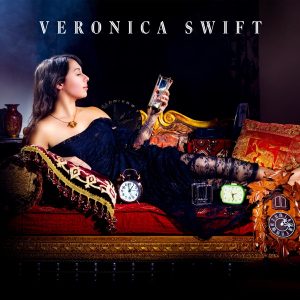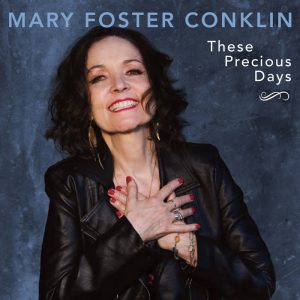Bistro Bits: Jazz and Cabaret…. Kissing Cousins or Estranged Siblings? Veronica Swift and Mary Foster Conklin Shed Some Light
Jazz and cabaret—two spheres, almost adjacent, yet set just apart.
I’ve often thought about the ways these two musical performance genres intersect and the ways they don’t. I have so many half-formed (and possibly half-baked) ideas about what each sphere consists of… some of them rooted in cliché and stored in cabinets of the brain that could probably use some cobweb clearing. Here’s some of the conventional wisdom, and likely some myths worth a-bustin’, that I’ve absorbed over the last several years….
Jazz is cerebral,
Cabaret is more on the emotional side.
Jazz is cool. Or it’s hot. When it’s warm, forget about it.
Cabaret seems fine with being warm (occasionally even “warm and fuzzy”), just not all the time.
Jazz performance is about notes and sounds. Lyrics? Sure…if they’re truly necessary. Jazz singers will sometimes forgo words altogether and move directly to scat-singing. Mucking around with a lyric is standard practice. (And if you’re, say, Ella in Berlin, you can go up on the lyric and magically transform the moment into one of the things for which you’re most fondly remembered.)
Cabaret is much more lyric-focused. If you’re a cabaret singer singing a “standard” and you deviate from the published lyric, there are listeners out there who can set you straight. With luck, this will happen after you get offstage.
Jazz is, at its core, African-American artistry.
Cabaret grew out of European traditions.
Jazz can be like a sporting event. Scat-singing and “vocalese” sometimes play like Olympic sporting events.
Cabaret is more like a subset of theatre. Then there’s the “revue”: a hybrid of cabaret and theatre. (More on revues another day.)
// //
Side Note: Interestingly, both cabaret and jazz have relied heavily on songwriters from musical theatre for repertoire. You know: Kern, Porter, Berlin, Rodgers & Hart, the Gershwins, Bernstein, Sondheim. But the jazz world has not been enthusiastic about Broadway-style singing. (Squaresville, man….) I find Newark jazz station WBGO to be very eclectic these days—even branching out to feature gospel and early rock on weekends. But I don’t recall hearing Judy Garland, Liza Minnelli, or Barbra Streisand played on the station, not even Streisand tracks from the album of hers produced by Diana Krall. Interestingly, though, in 1965, a young Streisand was named “favorite female jazz vocalist” in the annual Playboy jazz poll. Other celebrated jazz acts that scored in those mid-20th-century Playboy polls? Pat Boone and Peter, Paul, and Mary. I find this fairly hilarious. The times, they have a-changed!
Unlike WBGO, Manhattan’s Birdland, long a jazz citadel (with the occasional cabaret act), has—with the addition of a second, downstairs space—become a leading cabaret showcase. The first act I ever saw downstairs at Birdland was Lucie Arnaz.
Now, back to our laundry list….
// //
Jazz famously embraces informality, and improvisation is obviously a big part of the package. At many a jazz show, singers and musicians will begin with seemingly little or no thought about what exactly they’re going to perform and in what order. What cabaret artists call “patter” will tend to be brief and off the cuff in a jazz set.
Cabaret is big on preparation and presentation—on being polished entertainment. At a cabaret show, the set list tends to be…set. Sometimes it’s all but engraved. The patter between songs is often carefully worked out, down to the last syllable.
Jazz artists are about the music, not so much about the show-bizzy stuff. (Dress codes? Yeah, we heard about them somewhere?)
Cabaret artists are also about the music (and, again, the lyrics). But many also find value in showpersonship and are perfectly happy when there’s a big dose of glitz and glam involved.
Finally, Some Commonalities…
Though there are probably a good number of sourpusses in both arenas, it seems to me that jazz artists and cabaret performers alike tend to have a healthy sense of humor, sometimes even about themselves. It’s essential to sanity maintenance, and it keeps artists from throwing up their hands and becoming full-time realtors or dog walkers.
Also, both cabaret and jazz seem to honor their elders. Ageism seems not to be a big thing in either sector. Amen to that.
I can’t speak for everybody, but those are some of the notions rolling around in my head.
// //
The Bistro Awards honors both cabaret and jazz performers (along with comedy acts and other spoken-word shows). But sometimes there is overlap. 2023’s Bob Harrington Lifetime Achievement winner, Ronny Whyte, has straddled the gap between cabaret and jazz for decades. In fact, you’ll sometimes hear the term “jazz cabaret”—a label I associate most strongly with the late singer-pianist Barbara Carroll—applied to performers like Whyte.
And, of course, musicians in NYC —pianists, bassists, drummers and others—may play a cabaret show at 7pm and a jazz date at 9:30. And I don’t see their heads exploding over the dichotomy.
So, maybe all my concern with genres is much to-do about nada. Maybe what matters is, simply…what is the performer trying to do, and how well does the performer deliver?
With all this in mind, here are some thoughts on a couple of 2023 albums by vocalists who’ve been identified primarily as “jazz” performers.
For Veronica Swift: Experimentation Is Key
When I first saw Veronica Swift perform in a solo show, at Birdland a few years ago, I was impressed by the emotional connection she had to the songs in her fairly eclectic jazz repertoire. She was not aloof—she wore her heart on her sleeve like a big, crimson, lace-fringed Valentine, committing in an ardent way to each song she performed. On another occasion, a group show celebrating the “New York songs” of Ken Laub, she seemed very much a jazz-tinged cabaret singer. She’s apparently always liked experimentation. No matter what label you’d think of attaching to her, she seems perpetually on the prowl for new musical experience.
In her third studio album, titled simply Veronica Swift (Mack Avenue, 2023), released in September, she takes things up another level. She climbs onto several precarious artistic limbs to sing a repertoire that she’s described as “transgenre.” (In a chat with Swift for WBGO, singer/interviewer Janis Siegel called it “genre whiplash”—but Siegel apparently meant that in a good way.) Jazz may be “square one” for Swift on this album, but she embarks on wild excursions from that base. Blues, funk, classical music, Broadway, bossa nova, punk rock—she finds a use for it all. As she said in a television interview for WRTV in Indianapolis, “I wanted to take all my influences and connect them—see if I could connect Chopin to Judy Garland…Beethoven to Ray Charles…. It’s almost like a school project, if you think of it.”
The opening song (and the first single to be released from the album) is a driving rendition of Jerry Herman’s “I Am What I Am” that moves quickly into a hectic scat workout and then morphs into a fugue-y Bach-inspired interlude. Listen to it here.
Swift turns provocateur Trent Reznor’s creepy-pervy “Closer” into a percussion-heavy funk fest, sanitizing the most outrageous lyric. She connects “I’m Always Chasing Rainbows” (Harry Carroll, Joseph McCarthy (no, not that Joseph McCarthy) to its original Chopin source material, creating a lush reverie. Her rendition of “Chega de Saudade,” an early Antônio Carlos Jobim/Vinícius de Moraes tune, has had the familiar bossa-nova beat removed. The result is an elegant art song, with a dreamy orchestral background.
And so on.
Veronica Swift is not a cohesive album, nor do I think it was meant to be. You may replay certain tracks and skip over others. I like much of the album and am especially taken with Swift’s version of Charles Gounod’s “Je Veux Vivre.” But I found the punk-ification of “Don’t Rain on My Parade” (Jule Styne, Bob Merrill) to be a silly prank.
Summing up, and alluding to Jerry Herman’s previously mentioned lyric, does Swift get the “hook” or the “ovation”?
Yes, she does.
What Difference Does It Really Make?
Last month, I went to Manhattan’s Mezzrow club to hear Mary Foster Conklin sing. Packing into the small venue, I and my fellow sardines spent an hour marinating in this performer’s consummate artistry.
Many of the songs Conklin performed that night were from her February-released album, These Precious Days (Mock Turtle Music, 2023), which is blessed with gorgeous arrangements by pianist John di Martino. Talk about cohesion—here’s a CD in which everything hangs together thematically. Each song seems to have a piece of liberating wisdom for the listener, with lyrics that advocate for embracing change, living in the moment, seizing the day, gathering rosebuds while we may.
The lightest and funniest track is “Some Cats Know” (Jerry Leiber, Mike Stoller), originally sung by Leslie Uggams but more closely associated with Peggy Lee. Seething with steaminess and clever innuendo, it finds Conklin sorting out specimens of the human male into two buckets: those who know the score in the boudoir and those who are duds. This one was a crowd favorite at Mezzrow.
On the other end of the spectrum is the partly spoken “Scars” (Fran Landesman, Simon Wallace), a somber yet ultimately hope-filled look at the ways in which the traces of old wounds can become badges, helping to strengthen and stabilize the soul.
My favorite song from this album—and from the Mezzrow show—is Conklin’s take on André and Dory Previn’s “Just for Now,” a song that doesn’t just cope with change and impermanence but revels in it. As you can see and hear in this video (from a performance streamed from Brooklyn’s Soapbox Gallery last September), the splendid, sprightly-though-sometimes-melancholy playing of violinist Sara Caswell complements Conklin’s deep, throbbing, often almost-whispered vocals in a highly engaging way.
My night with Conklin at Mezzrow was one for the memory bank. That said, I’d be hard-pressed to say whether I’d experienced a cabaret show or a jazz set.
But, why get all hair-splitty? When it’s consistenly brilliant, does the genre really matter?
###
Ed. Note: For another look at These Precious Days, read Gerry Geddes’s recent review here.)
About the Author
Mark Dundas Wood is an arts/entertainment journalist and dramaturg. He began writing reviews for BistroAwards.com in 2011. More recently he has contributed "Cabaret Setlist" articles about cabaret repertoire. Other reviews and articles have appeared in theaterscene.net and clydefitchreport.com, as well as in American Theatre and Back Stage. As a dramaturg, he has worked with New Professional Theatre and the New York Musical Theatre Festival. He is currently literary manager for Broad Horizons Theatre Company.







From John Meyer: I’d like to comment on the performers of jazz and cabaret,
a dichotomy I’ve studied all my life.
In jazz, the music is most important; in cabaret it’s the lyric.
Jazz singers often forfeit lyric values in favor of musical
experimentation; Bettye Carter for example, who once said
“A song is much more than its words and melody, you know.”
It takes a great artist to replace the composer and lyricist’s
imagination with their own; very few do it successfully;
Miles Davis is one. Scatting is simply ornamentation,
nothing to do with the dramatic value of the tune.
Few artists can achieve the perfect balance; my favorites are
Barbara Carroll and Carmen MacRae, neither of whom ever sacrifices one element
of the song for another.